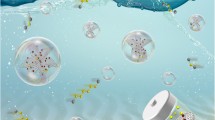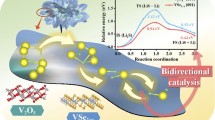Abstract
Lithium-sulfur battery (LSB) is renowned for its high energy density storage property yet its development has faced significant challenges including the shuttle effect and slow reaction rates. A vanadium nitride quantum dots decorated N-doped hollow carbon nanosphere (VN@CS) is thus synthesized and applied as the sulfur host material in LSBs. Experimental results demonstrate the efficient adsorption and catalytic conversion character of the polar VN for soluble lithium polysulfides (LiPSs), contributing to an effective inhibition of the shuttle effect and acceleration of LiPSs conversion. Consequently, the S/VN@CS cathode exhibits a high specific capacity of 849.1 mA h g−1 at a high current density of 4 C, along with the long cycling performance, achieving 1000 cycles with a low capacity decay rate of 0.038% per cycle at 2 C. The work presents the successful combination of small yet highly efficient quantum dots with a conductive substrate to achieve excellent electrochemical performances of LSBs.




Similar content being viewed by others
References
Kang Q, Li Y, Zhuang Z et al (2022) Dielectric polymer based electrolytes for high-performance all-solid-state lithium metal batteries. J Energy Chem 69:194–204
Zhao X, Wang C, Li Z et al (2021) Sulfurized polyacrylonitrile for high-performance lithium sulfur batteries: advances and prospects. J Mater Chem A 9(35):19282–19297
Manthiram A, Chung SH, Zu C (2015) Lithium-sulfur batteries: progress and prospects. Adv Mater 27(12):1980–2006
Bruce PG, Freunberger SA, Hardwick LJ et al (2011) Li-O2 and Li-S batteries with high energy storage. Nat Mater 11(1):19–29
Wei C, Xi B, Wang P et al (2023) In situ growth engineering on 2D MXenes for next-generation rechargeable batteries. Adv Energy Sustain Res 4(11):2300103
Long J, Yu H, Liu W (2024) Structure engineering of cathode host materials for Li–S batteries. Rare Met 43(4):1370–1389
Shen N, Sun H, Li B (2023) Advances on dual-functional hosts for polysulfides conversion and lithium plating/stripping towards lithium−sulfur full cells. Chem A Eur J 29(11):e202203031
Li B, Wang P, Xi B et al (2022) In-situ embedding CoTe catalyst into 1D–2D nitrogen-doped carbon to didirectionally regulate lithium-sulfur batteries. Nano Res 15(10):8972–8982
Yuan J, Xi B, Wang P et al (2022) Multifunctional atomic molybdenum on graphene with distinctive coordination to solve Li and S electrochemistry. Small 18(37):2203947
Boyjoo Y, Shi H, Olsson E et al (2020) Molecular-level design of pyrrhotite electrocatalyst decorated hierarchical porous carbon spheres as nanoreactors for lithium–sulfur batteries. Adv Energy Mater 10(20):2000651
Hu Y, Chen W, Lei T et al (2020) Strategies toward high-loading lithium–sulfur battery. Adv Energy Mater 10(17):2000082
Huang L, Li J, Liu B et al (2020) Electrode design for lithium–sulfur batteries: problems and solutions. Adv Funct Mater 30(22):1910375
Qin B, Wang Q, Yao W et al (2023) Heterostructured Mn3O4-MnS multi-shelled hollow spheres for enhanced polysulfide regulation in lithium–sulfur batteries. Energy Environ Mater 6(6):e12475
Wang Y, Wang P, Yuan J et al (2023) Binary sulfiphilic nickel boride on boron-doped graphene with beneficial interfacial charge for accelerated Li–S dynamics. Small 19(29):202208281
Wang P, Zhang Z, Song N et al (2023) WP nanocrystals on N, P dual-doped carbon nanosheets with deeply analyzed catalytic mechanisms for lithium–sulfur batteries. CCS Chem 5(2):397–411
Ning SONG, Baojuan XI, Peng WANG et al (2022) Immobilizing VN ultrafine nanocrystals on N-doped carbon nanosheets enable multiple effects for high-rate lithium–sulfur batteries. Nano Res 15(2):1424–1432
Nguyen TT, Balamurugan J, Go HW et al (2022) Dual-functional Co5.47N/Fe3N heterostructure interconnected 3D N-doped carbon nanotube-graphene hybrids for accelerating polysulfide conversion in Li-S batteries. Chem Eng J 427:131774
Puttaswamy R, Pai RK, Ghosh D (2022) Recent progress in quantum dots based nanocomposite electrodes for rechargeable monovalent metal-ion and lithium metal batteries. J Mater Chem A 10(2):508–553
Baker SN, Baker GA (2010) Luminescent carbon nanodots: emergent nanolights. Angew Chem Int Ed Engl 49(38):6726–6744
Fowley C, Nomikou N, McHale AP et al (2013) Extending the tissue penetration capability of conventional photosensitisers: a carbon quantum dot-protoporphyrin IX conjugate for use in two-photon excited photodynamic therapy. Chem Commun (Camb) 49(79):8934–8936
Mori R (2023) Cathode materials for lithium-sulfur battery: a review. J Solid State Electrochem 27(4):813–839
Cai D, Wang L, Li L et al (2019) Self-assembled CdS quantum dots in carbon nanotubes: induced polysulfide trapping and redox kinetics enhancement for improved lithium–sulfur battery performance. J Mater Chem A 7(2):806–815
Li F, Zhang M, Chen W et al (2021) Vanadium nitride quantum dots/Holey Graphene Matrix boosting adsorption and conversion reaction kinetics for high-performance lithium-sulfur batteries. ACS Appl Mater Interfaces 13(26):30746–30755
Ma F, Srinivas K, Zhang X et al (2022) Mo2N quantum dots decorated n-doped graphene nanosheets as dual-functional interlayer for dendrite-free and shuttle-free lithium-sulfur batteries. Adv Fun Mater 32(40):2206113
Huang Y, Wang W, Shan J et al (2020) High volumetric energy density Li-S batteries enabled by dense sulfur monolith cathodes with ultra-small-sized sulfur immobilizers. Chem Eng J 401:126076
Yu B, Huang A, Chen D et al (2021) In situ construction of Mo(2) C quantum dots-decorated CNT networks as a multifunctional electrocatalyst for advanced lithium-sulfur batteries. Small 17(23):e2100460
Zhang C, Li B, Zhu K et al (2023) Accelerating electrochemical reactions in Li-S batteries through better dispersion of sulfur and the robust catalytic effect upon the vanadium nitride decorated hollow carbon spheres. App Surf Sci 614:156268
Zhang H, Yu M, Song H, Noonan O, Zhang J, Yang Y, Zhou L, Yu C (2015) Self-organized mesostructured hollow carbon nanoparticles via a surfactant-free sequential heterogeneous nucleation pathway. Chem Mater 27(18):6297–304
Sun W, Liu S, Li Y et al (2022) Monodispersed FeS2 electrocatalyst anchored to nitrogen-doped carbon host for lithium–sulfur batteries. Adv Funct Mater 32(43):2205471
Yu B, Ma F, Chen D et al (2021) MoP QDs@graphene as highly efficient electrocatalyst for polysulfide conversion in Li-S batteries. J Mater Sci Technol 90:37–44
Li K, Sun Y, Shi K et al (2023) Competing polysulfides conversion between edge-N and embedded CoS2 within multichannel carbon nanofibers. Chem Eng Sci 282:119236
Lin Y, Tang W, Wu S et al (2023) Alleviating the self-discharge and enhancing the polysulphides conversion kinetics with LaCO3OH nanocrystals decorated hierarchical porous carbon. Chem Eng J 452:139091
Xu J, An S, Song X et al (2021) Towards High Performance Li-S Batteries via Sulfonate-Rich COF-Modified Separator. Adv Mater 33(49):e2105178
Zhang Y, Kang C, Zhao W et al (2023) d-p hybridization-induced “trapping-coupling-conversion” enables high-efficiency Nb single-atom catalysis for Li-S batteries. J Am Chem Soc 145(3):1728–1739
Qiao L, Ren L, Zhang R et al (2021) Hollow carbon spheres embedded with VN quantum dots as an efficient cathode host for lithium-sulfur batteries. Energy Fuels 35(12):10219–10226
Li L, Luo Y, Wang Y et al (2023) Rational design of a well-aligned metal–organic framework nanopillar array for superior lithium-sulfur batteries. Chem Eng J 454:140043
Zhang M, Guo Y, Wei Y et al (2020) Integrating conductivity and active sites: Fe/Fe3C@GNC as an trapping-catalyst interlayer and dendrite-free lithium host for the lithium–sulfur cell with outstanding rate performance. J Mater Chem A 8(36):18987–19000
Zhang X, Lei M, Tian S et al (2024) Cage-confinement synthesis of MoC nanoclusers as efficient sulfiphilic and lithiophilic regulator for superior Li–S batteries. Rare Met 43(2):624–634
Dan-Yang WANG, Wenmin WANG, Fengli LI et al (2022) Nitrogen-rich azoles as trifunctional electrolyte additives for high-performance lithium-sulfur battery. J Energy Chem 71:572
Zhou S, Yang S, Cai D et al (2022) Cofactor-assisted artificial enzyme with multiple Li-bond networks for sustainable polysulfide conversion in lithium-sulfur batteries. Adv Sci 9:2104205
Hou T, Xu W, Chen X et al (2017) Lithium bond chemistry in lithium-sulfur batteries. Angew Chem Int Ed 56(28):8178–8182
Bai Y, Nguyen TT, Chu R et al (2023) Core-shell hollow nanostructures as highly efficient polysulfide conversion and adsorption cathode for shuttle-free lithium-sulfur batteries. Chem Eng J 454:140338
Xiao H, Li K, Zhang T et al (2023) High loading atomically distributed Fe asymmetrically coordinated with pyridinic and pyrrolic N on porous N-rich carbon matrix driving high performance of Li-S battery. Chem Eng J 471:144553
Zhang L, Liu Y, Zhao Z et al (2020) Enhanced polysulfide regulation via porous catalytic V(2)O(3)/V(8)C(7) heterostructures derived from metal-organic frameworks toward high-performance Li-S batteries. ACS Nano 14(7):8495–8507
Sun R, Bai Y, Luo M et al (2021) Enhancing polysulfide confinement and electrochemical kinetics by amorphous cobalt phosphide for highly efficient lithium-sulfur batteries. ACS Nano 15(1):739–750
Zhang X, Yuan W, Huang H et al (2022) Rational design and low-cost fabrication of multifunctional separators enabling high sulfur utilization in long-life lithium-sulfur batteries. Int J Extreme Manuf 5(1):015501
Jing EA, Chen L, Xu SA et al (2022) Dual redox catalysis of VN/nitrogen-doped graphene nanocomposites for high-performance lithium-sulfur batteries. J Energy Chem 64:574–582
Tao X, Wang J, Liu C et al (2016) Balancing surface adsorption and diffusion of lithium-polysulfides on nonconductive oxides for lithium-sulfur battery design. Nat Commun 7:11203
Rui XH, Ding N, Liu J et al (2010) Analysis of the chemical diffusion coefficient of lithium ions in Li3V2(PO4)3 cathode material. Electrochim Acta 55(7):2384–2390
Huang X, Tang J, Luo B et al (2019) Sandwich-like ultrathin TiS2 nanosheets confined within N, S codoped porous carbon as an effective polysulfide promoter in lithium-sulfur batteries. Adv Energy Mater 9(32):1901872
Tu S, Chen X, Zhao X et al (2018) A polysulfide-immobilizing polymer retards the shuttling of polysulfide intermediates in lithium-sulfur batteries. Adv Mater 30(45):e1804581
Zhang Y, Ma C, He W et al (2021) MXene and MXene-based materials for lithium-sulfur batteries. Prog Nat Sci: Mater Int 31(4):501–513
Acknowledgements
The work reported here was supported by the National Natural Science Foundation of China under Grant No. 51972186, JMRH Program of Qingdao Ocean Equipment Technology Innovation Center. We express our grateful thanks to them for their financial support.
Author information
Authors and Affiliations
Corresponding author
Additional information
Publisher's Note
Springer Nature remains neutral with regard to jurisdictional claims in published maps and institutional affiliations.
Supplementary Information
Below is the link to the electronic supplementary material.
Rights and permissions
Springer Nature or its licensor (e.g. a society or other partner) holds exclusive rights to this article under a publishing agreement with the author(s) or other rightsholder(s); author self-archiving of the accepted manuscript version of this article is solely governed by the terms of such publishing agreement and applicable law.
About this article
Cite this article
Yu, M., Fu, W., Wang, M. et al. Decorating highly efficient VN quantum dots onto N-doped hollow carbon nanospheres enables effective inhibition of the shuttle effect and acceleration of LiPSs conversion in lithium–sulfur batteries. J Solid State Electrochem (2024). https://doi.org/10.1007/s10008-024-05883-w
Received:
Revised:
Accepted:
Published:
DOI: https://doi.org/10.1007/s10008-024-05883-w




